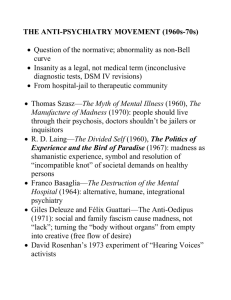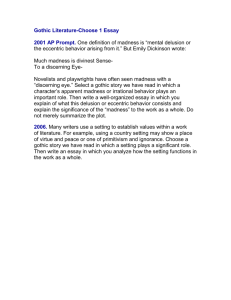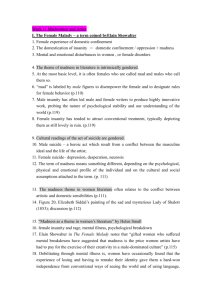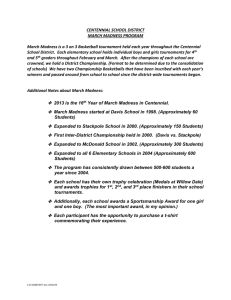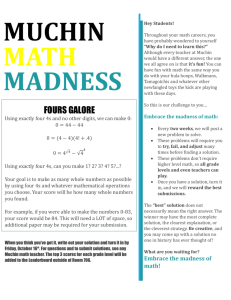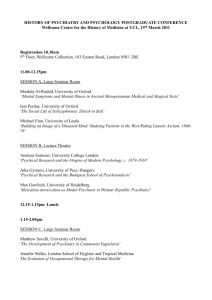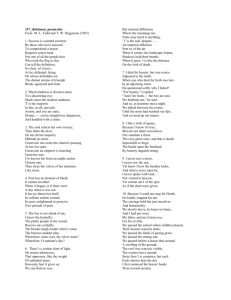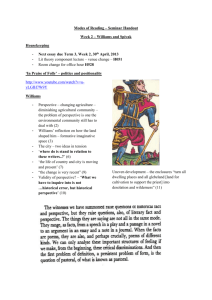History of Mental Illness presentation
advertisement
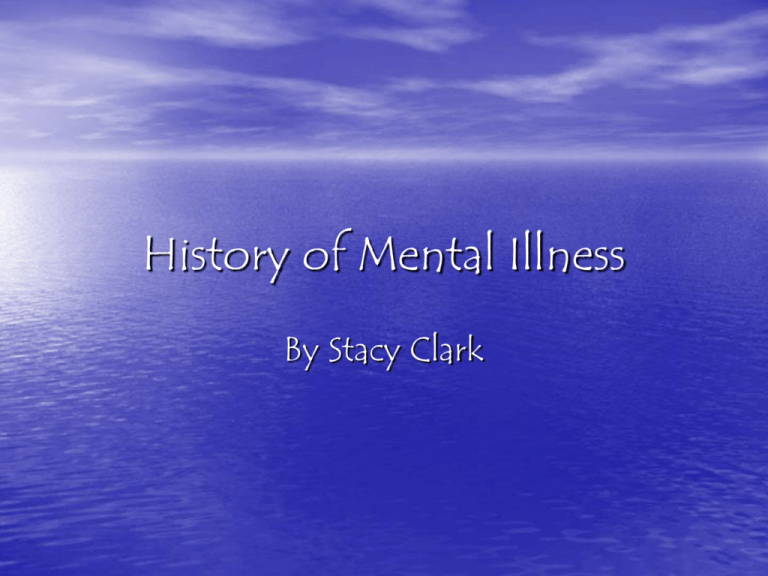
History of Mental Illness By Stacy Clark Classical Understandings Early Greek Literature & Mythology Homer: Iliad- Ajax Gods blamed for the “sacred disease” Healing: prayers, sacrifices to Asklepios, god of healing Drama Aeschylus, Sophocles, Euripides Madness often results as “Psychic civil war becomes endemic to the human condition” and introspection begins to dominate drama Medea Greco-Roman custom Violence, cannibalism, grief seen as markers No asylums; family responsibility for care Fear of contagion from evil spirits (keres) Cure for hysteria (“wandering uterus”): marriage Idea of “melancholy genius” Plato, Aristotle Early Medicalization Hippocrates (ca. 460-357 BC): natural explanation for epilepsy “naturalization of madness” “…the sacred disease appears to me to be no more divine nor more sacred than other diseases, but has a natural cause from which it originates like other afflictions. Men regard its nature and cause as divine from ignorance and wonder, because it is not like other diseases.” Mania and melancholia: excitement/depression Humoral theory (usually choler, black bile) Melancholy madness sometimes seen as genius (i.e. modern ideas of bipolar creativity) Plato Timaeus, 375 B.C.E: Physiological cause of madness, therefore possibility of treatment by medical means Also, concept of “madness as a transcendental divine fire with the power to inspire” “Naturalistic Notions” Galen!! Mania: disease of yellow bile (the heart) “hot” disease called for cooling treatment Soranus Mental illness caused by: “continual sleeplessness, excesses of venery, anger, grief, anxiety, or superstitious fear, a shock or blow, intense straining of the senses and the mind in study, business, or other ambitious pursuits” Arataeus of Cappadocia (contemporary of Galen, 150-200 C.E.) Descriptions of mental disorders (depression, mania, melancholy, bipolar disorders) and epilepsy – “one believes himself a sparrow; … or they believe themselves a grain of mustard, and tremble continuously for fear of being eaten by a hen.” – Criticized Dionysian frenzies as disgraceful • Greek ideas dominated medical thought for centuries, providing basis for medieval European and Islamic thought Biblical Examples Madness as divine punishment: Deuteronomy 6:5, “The Lord will smite thee with madness” King Nebuchadnezzar New Testament examples of Jesus healing demonic possession Non-Western Antiquity Hinduism Goddess Grahi (“she who seizes”) India Dog-demon Mesopotamia and Babylon Spirit invasion, the evil eye, demonic power, breaking of taboos led to mental disorder “If at the time of his possession his mind is awake, the demon can be driven out; if at the time of his possession is not so aware, the demon cannot be driven out.” ~Assyrian text, 350 B.C.E. Early Christianity: “Holy Madness” vs. Diabolic Possession Supernatural forces battled for possession, leading to despair, anguish, etc “Madness of the Cross”- “ecstatic revelations of saints and mystics” But cause usually diabolic, spread by heretics, witchcraft Anatomy of Melancholy (1621): Richard Burton (Oxford): sick people particularly susceptible to Devil, “true author of despair and suicide” Religious Treatments Spiritual treatment for unclean spirits: masses, exorcism, pilgrimages (Catholicism) Insane cared for in religious hospitals, houses Prayer, counsel, Bible reading (Protestantism) Madness as Heresy Reformation and Counter-Reformation Political purposes of diagnosis “False doctrine and delusion formed two sides of the same coin: the mad were judged to be possessed, and religious adversaries were deemed out of their mind.” Madness as Blaspheming against God Mental anguish bringing sinners to acute spiritual crisis, leading (hopefully) to recovery Conversion narrative of George Trosse (b.1631) Witch Hunts Late 15th cent, peak around 1650 Unusual speech and behavior sign of consorting with the Devil; satanic maleficium (malice) Over 200,000 people (primarily women) executed Led to popular and official skepticism of the doctrine of demonic possession Skepticism of Witchcraft Johannes Weyer (1515-1588): De Praestigiis Daemonum witches to be “pitied and treated, not feared and punished” Product of imaginations or hallucinogenic substances Natural disasters as cause of “crimes” Devil’s power somewhat limited by God Dr. Edward Jorden (1569-1632): naturalistic explanation Hysteria: “suffocation of the mother” Womb bred “vapours” which unbalanced body, leading to odd behavior attributed to possession Relied on Galenic concepts Biological explanation Humoral theory: Obstructions, vapors as causes Misogyny remained: Witches became hysterical women Witch-hunting ultimately failed as tool of enforcing social order Comparisons drawn between religious extremists and mentally ill Result of 30 Years War (1618-48), English Civil Wars (164251) Similar behavior: speaking in tongues, convulsions, “weeping and wailings” Zeal a sign of mental instability Renaissance anatomy and physiology begin to displace Greek humoral theory – Vesalius, Harvey Thomas Willis Coined term “neurologie” Excluded demonic possession from consideration Biological explanation for mental illness Enlightenment Europe • The rest of Europe retained beliefs in possession longer than England – by 1700, most of Europe believed in natural explanation • Elites scorned religious explanations in favor of natural causes – Religious beliefs became concern of psychopathology – Blame placed on Methodists for surviving popular belief in witchcraft/possession • Pathologization of religion in general – Mainly Enlightenment free-thinkers – Philosophes (Voltaire, Diderot) saw Christianity as function of “sick brains” • Doctors replace clergy as healers Reason and Rationality • Rene Descartes (1594-1650) Dualism: mind and body disconnect Mental illness ascribed to problems between mind and body Implied that “insanity, precisely like regular physical illnesses, must derive from the body” Thomas Hobbes (1588-1679) – Materialistic worldview • “insanity was thus erroneous and thought caused by some defect in the body’s machinery” • John Locke (1632-1704): – insanity delusional; caused by faulty cognitive processes • Romantic ideas of madness for artists/ writers: Madness as creative genius or “melancholy malcontent” – Shakespeare: Hamlet, King Lear, Feste (12th Night) – Cervantes: Don Quixote • Famous writers/poets suffering from madness/mental breakdowns – Shelley, Byron, Rousseau, Pascal, Poe, Nijinsky, Sylvia Plath, Virginia Woolf • Parisian avant-garde society: true art from mental/physical sickness – Hashish, opium, absinthe crucial to this phase – Critique of bourgeois values • Medicalization of mental illness led to less romantic ideas about madness • St. Mary of Bethlehem (Bedlam), mental hospital founded in 1247, open to public to teach moral lessons about excess • George III (1788)- fodder for satirists “Fashionable Melancholy” • Nervous diseases become fashionable – Seen as afflictions for privileged upper classes and “refined temperaments” – Hypochondria (male) & hysteria (female) – Victorian women develop stereotype of “depressive, hysterical, suicidal, and selfdestructive behavior” Institutionalization • Traditionally, insane cared for at home or in • religious institutions such as Bedlam Foucault: locking away of undesirables during the rise of absolutism; method of control, not cure – Led to dehumanization; positive aspects of mental illness forgotten • Possibly oversimplified argument – Russia lack of institutions until 1850s – Few institutions in Portugal and rural Europe • Porter argues institutionalization was a function of social changes, not government • Most institutions private • Medical oversight not required in England until • after 1820s Wide range of care; some helpful, others cruel – Genre of patient literature exposed abuses and neglect • Around 1800, increased optimism and personal care – Medicine, surgery, traditional methods downplayed in favor of personal cure regimens • Psychiatry develops as a method of therapy for • patients Previous therapies relatively barbaric: physical restraints, purging, bloodletting • Florence – Humanity of patients emphasized • Paris – Revolutionary ideals led to improved standard of treatment – Pinel: “treatment must penetrate to the psyche” – Mock trial of tailor • Reforms, Certification of Asylums in England, France, USA attempted to raise quality of care – 1770s-1830s • 19th century: huge increase in number, scale of asylums in Europe – England: 10,000 in 1800 to 100,000 in 1900 – Italy: 8,000 in 1881 to 40,000 in 1907 – Probably reactions to industrialization and urbanization • Non-restrictive therapy in England (Hill, Conolly • 1830s) “Work therapy” in France and Germany • Importance of classification and separation – Men from women, dangerous from safe, clean from dirty, etc. • During last third of 19th century, pessimism about lack of ability to cure patients replaces early optimism – Asylums expanded dramatically – Many patients remained in incurable states – Personal care and quality begins to deteriorate • “formal drills, financial stringency, and drug routines meant to pacify, sedate, and stupefy” – Underlying social and cultural factors • Economics, government paternalism, scientific secularism • Madness as physical disorder – – – – • Herman Boerhaave, Friedrich Hoffmann End of humoral theory and focus on liquid Solidist physiology: solid parts of body more important than liquids Nervous system becomes site of inquiry Somatic approach • John Locke (1632-1704) – Madness a flaw in mechanism where senses are turned into ideas – Very influential in Britain, France • Benjamin Rush (1745-1813) – “father of American psychiatry” – Mental disorders due to “vitiated blood” – Bloodletting as best cure • William Cullen (1710-1790) – Used Locke’s philosophical ideas, but returned to medical emphasis – Psychological aspect of disorder – Irritation of the nerves/excess in brain activity precipitated madness; insanity as a nervous disorder – Biological basis: “mental disorder grounded in neurophysiology” • By 1780, somatic system (of Boerhaave, etc.) out of date – Led to concern about the patient’s psyche – Case-history approach led to “systematic psychological observation” • Vincenzo Chiarugi (Florence, 1759-1820) – Senses and nervous systems of the body affected the mind – Therapy of “moral control,” doctor setting positive examples for patients – Mental illness acquired, not hereditary – Optimistic about cure • Philippe Pinel (Paris, 1745-1826) – Similar ideas – Evidence did not show structural abnormalities in autopsies of mentally ill brains; therefore, most were curable through therapy – Also optimistic about effectiveness of moral therapy • Jean-Etienne Dominique Esquirol (1772-1840) – Mental Maladies (1838) very influential – Cited biological basis of mental disorders, but focused on psychosocial triggers – Supporter of asylums; Briefly housed the Marquis de Sade • German Psychiatry – – – Unlike Britain and France, university and researchbased Contentious arguments between psychological and organic theorists More investigative than therapeutic; focused more on diseases than patients • J.C.A. Heinroth (1773-1843) – Mental illness caused by sin • “not from the body but from the soul itself” – Insanity a voluntary rejection of divine gift of free will • Ernst von Feuchtersleben (Vienna, 1806-1849) – – Psychiatry based on personality “psychopathy” as disease of entire personality; modern concept of psychosis • Phrenology – Viennese anatomists Gall and Spurheim – “seat of the mind was the brain, whose configurations both determined and displayed the personality” – Appearance of bumps on the head in specific areas could determine psychological characteristics • “Medical Materialism” buttressed by theories such as phrenology – Helped make psychiatry exclusive to sanctioned physician-researchers – Maintained physical therapies such as bleeding, purging, sedatives • Wilhelm Griesinger (Berlin) – 1845: “mental illnesses are brain diseases” – Underlying abnormalities/brain irritation led to worsening (irreversible) conditions; natural slope of mental illness was deterioration – Somatic explanation spurred research and led to less stigmatization of patients – Tried to unite psychiatry and neurology in clinics; wanted to keep psychiatry united with medicine • Carl Wernicke (1848-1905) – “German neuropsychiatry at its apogee” – Interests in disorders of language and speech, particularly stroke damage • Wernicke’s aphasia – Mapping of cerebral cortex – Manual of Brain Diseases (1881-3) important attempt to attribute symptoms in physical abnormalities of brain – Concept of dominance of cerebrum • Neurasthenia (George Beard, 1839-1883) – Nervous breakdown because of pressure of modern civilization – “nerve force” of individuals drained – Struck elite, just as earlier diagnoses of hysteria – Stereotypically American disease • German pessimism – “therapeutic nihilism born of experience bred a new herediterianism” – Asylums becoming crowded with (then untreatable) sufferers of tertiary syphilis – Alcoholism provided quintessential model • France picked up on pessimistic degenerative theories – Defeat by Prussia 1870, subsequent bloody Paris commune, bourgeois fears of social unrest provoked uneasy public mood • Marking of “inferior” members of society promoted misogyny, racism, eugenics – Physical characteristics of people and races – Sterilization and confinement of undesirables • In US before Nazi Germany • Psychiatry in Law – Britain • After 1799 trial of James Hadfield, defendants could be not guilty by reason of insanity • M’Naghten Rules established insanity defense as inability to tell right from wrong – France • “irresistible impulse” and temporary insanity (crime passionelle) enough to establish innocence – Disputes between law and psychiatry led to confusion, damaged opinion of psychiatry • Patient complaints – Much literature exists complaining that the inmates of Bedlam were the sane ones; the doctors were crazy/cruel – Expression in art, essay, poetry – 1870s: attention to art produced by patients as way of diagnosis – Art therapy – Avant-garde artists, by virtue of similarity to patients’ work, called insane • Surrealists, Expressionists, Cubists • Cezanne • Emil Kraeplin (1856-1926) – German, wanted to establish psychiatry as scientific, respected field – Dementia praecox: precursor of schizophrenia – Loaded language such as “atrophy of the emotions” suggested lack of humanity • Alois Alzheimer (1864-1915) – Senile dementia – Geriatric research • Nazi psychiatry – Lives of mentally ill not worth it – January 1940- September 1942: 70,723 mental patients gassed – Taken from lists of leading psychiatrists and psychologists • Freud (1856-1939) • Materialist approach, dismissive of religion – Psychoanalysis • • • • • • Oedipus Complex Unconscious mind Repression and neuroticism Sexuality (esp. in children) Ego, superego, id Free association and dream interpretation • Carl Jung (1875-1961) – Feud with Freud – Collective unconscious • Lamarckian theory – Fascination with archetypes and myths • Alfred Adler (1870-1937) – Inferiority complex – Importance of social relations – Important in interwar treatment • US focus of psychoanalytic movement • Melanie Klein and Anna Freud – Disputes in field over relationships between mothers and children • By 1950’s, psychoanalysis imbedded in American practice and society – Mental disorder not confined to bad cases – Ordinary people suffered from neuroses, complexes, etc • Alcoholism, adjustment problems, family problems, juvenile delinquency • Discovery of bacteria led to cures of syphilis, which caused mental illness • 1920s: dubious trends – Electric shock therapy – Barbiturates and prolonged-sleep – Insulin coma (schizophrenia) • 1930s: psychosurgery – Leucotomy: separation of frontal lobes and rest of brain – Lobotomy • 18,000 by 1951 – Often made patients submissive; some able to re-enter society – Well-meaning doctors, but criticized as overly aggressive – Methamphetamines came into use • 1940s: penicillin! – Led to rise of pharmacology – 1949: first psychotropic (moodinfluencing) drug introduced for bipolar disorder • 1950s – Anti-psychotic and anti-depressant drugs – Many could leave asylums under medical regimens with new drugs • Valium introduced 1960s • Prozac 1987 – Increased serotonin created “feel-good” sensation – Within 5 years, 8 million people tried • Karl Menninger – “Gone forever is the notion that the mentally ill person is an exception. It is now accepted that most people have some degree of mental illness at some time.” (1956) • More attention on milder cases • Anti-psychiatry movement, • 1960s and 1970s – Supported deinstitutionalization Sources: • Roy Porter. Madness: A Brief History. Oxford, Oxford University Press, 2002. • Pictures: Wikipedia.org, • • http://images.google.com/imgres?imgurl=http://www.gjpsy.uni-goettingen.de/gjp-madnesscover.jpg&imgrefurl=http://www.gjpsy.uni-goettingen.de/gjp-madnessdownload.htm&h=771&w=593&sz=54&hl=en&start=28&tbnid=OPHXHXdmYUr6wM:&tbnh=142& tbnw=109&prev=/images%3Fq%3Dmadness%26start%3D20%26gbv%3D2%26ndsp%3D20%26 svnum%3D10%26hl%3Den%26sa%3DN http://images.google.com/imgres?imgurl=http://www.bc.edu/bc_org/avp/cas/fnart/art/19th/paint ing/bell_madness.jpg&imgrefurl=http://sciowithbrio.wordpress.com/2007/06/01/10416/&h=477& w=409&sz=62&hl=en&start=71&tbnid=kKiIJ272cnYHDM:&tbnh=129&tbnw=111&prev=/images %3Fq%3Dmadness%26start%3D60%26gbv%3D2%26ndsp%3D20%26svnum%3D10%26hl%3D en%26sa%3DN
